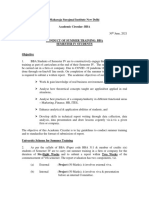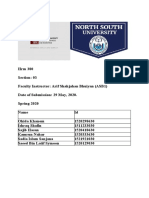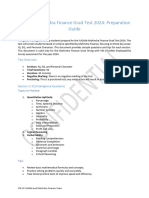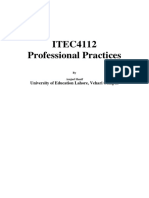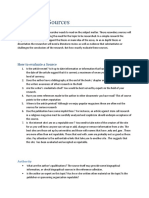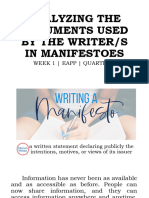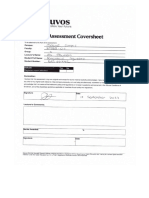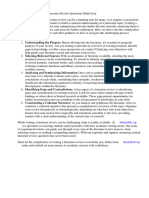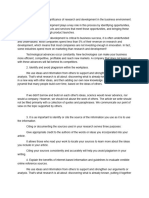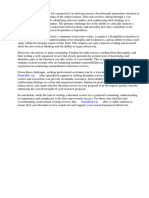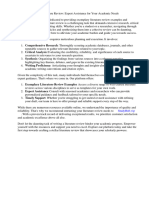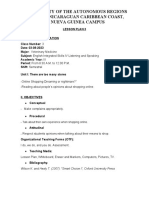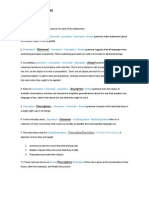IIMA Style Guide 2004
IIMA Style Guide 2004
Uploaded by
taxilainCopyright:
Available Formats
IIMA Style Guide 2004
IIMA Style Guide 2004
Uploaded by
taxilainCopyright
Available Formats
Share this document
Did you find this document useful?
Is this content inappropriate?
Copyright:
Available Formats
IIMA Style Guide 2004
IIMA Style Guide 2004
Uploaded by
taxilainCopyright:
Available Formats
Indian Institute of Management Ahmedabad
IIMA Citation Style Guide For Presenting Assignments
(PGP/ PGP-ABM/FPM/FDP)
Version 1
Prepared by M.M. Monippally, B.S. Pawar Kaustubh Nande, Babita Deou
Citation style based on the Publication Manual (5th edition) of the American Psychological Association (APA)
2004 by Indian Institute of Management, Ahmedabad. No part of this document may be reproduced without the written permission of IIMA.
Contents
Foreword Dear Students Indira J Parikh, Dean M.M. Monippally & B.S. Pawar 03 04 05 15 15 15 17 18 18 20 22
Part One: Why Take the Trouble? Part Two: Illustrations
Section A: In-text Citations A1 In-text citations (print sources) A2 In-text citations (electronic sources) Section B: References B1 References to Print Sources Journal articles Books B2 Electronic Sources
Foreword
I have great pleasure in commending this citation style guide to the academic community at IIMA. Students will find it very useful when writing assignments and making oral presentations. Written in a very reader-friendly style, this guide first sensitizes students to the consequences of intended and unintended plagiarism and impresses on them the advantages of acknowledging ones sources accurately. The carefully selected illustrations of references to print and electronic sources students of management are likely to access enhance the value of this guide further. So far the Institute never prescribed any style for adoption either in written assignments or oral presentations. In a multidisciplinary institution such as IIMA it will be unreasonable to insist on any one particular style for all subjects. However, I enthusiastically recommend this style guide for adoption by Faculty and students in areas where this is appropriate. As the guide is available online, members of the student community can consult it as they write their assignments or plan their oral presentations. Although this citation style guide is intended primarily for students and academic associates, I am sure that faculty also will find this guide handy. Do mail the authors your suggestions for improvement.
Indira J. Praikh Dean August 2, 2004
Dear Students:
Here is a simplified guide to documenting sources from which you borrow ideas to enrich your written assignments and technical presentations. While a standard style guide covers a wide range of aspects of writing including formatting, this guide focuses only on citation. It is based on the APA style, widely used in management and social sciences. The guide is divided into two parts. Part One recognizes different levels of scholarly borrowing and shows you why it is important to acknowledge your sources scrupulously and how it enhances your reports, papers, and presentations. It also draws a line between the kind of sources you need not acknowledge and the ones you ought to. Part One is written in a way that balances the need for precision with the need for readability. Part Two illustrates how to acknowledge borrowings from different sources, including electronic. We have anticipated the kinds of sources you are most likely to access for reliable data and ideas. We may have missed out some. Do bring them to our notice so that we can include them in the next edition. In order to keep the guide simple and easy to use, we have deliberately left out sources and situations that are not very common in management writing at the student level. If you want to go into them, you have the comprehensive 5th edition of APAs Publication Manual (2001) in the Institute library. If you are preparing papers for publication, you must, of course, follow the relevant journals style guidelines. We look forward to receiving your comments and suggestions on any aspect of this guide. If you find any inaccuracy or inconsistency, please bring it to our notice. Please mail your suggestions to <mpally@iimahd.ernet.in> or <bspawar@iimahd.ernet.in> Thank you.
Matthukutty M Monippally Badrinarayan S Pawar
August 2, 2004
Part One WHY TAKE THE TROUBLE?
Ethics of Research and Communication Most of us dont steal. Ever. Even when we can get away with it. We have been taught from childhood that it is wrong to take other peoples things without their permission. We would die of embarrassment if we were seen using stolen goods. Yet often we forget or ignore this basic tenet of social living when we deal with unprotected intellectual property. We borrow products of other peoples intellectual or artistic efforts and fail to acknowledge the owners or even flaunt them as if they were our own. This is plagiarism stealing intellectual property. It is wrong. There is nothing shameful about borrowing other peoples ideas. They are a resource that sharing does not dry up. We stand on the shoulders of those who went before us. We can borrow and combine insights from different sources and create new insights and new knowledge. That is how science grows. But we must acknowledge borrowed ideas. Complete and scrupulous acknowledgement of source documents helps us to comply with the ethical principles of scholarly writing which enjoin us, in the words of the APA Publication Manual (2001, p. 348), to ensure the accuracy of scientific and scholarly knowledge, and to protect intellectual property rights. Of course we shouldnt take acknowledgements to ridiculous extremes. There is a huge fund of knowledge that belongs to everyone, rather like public roads. Each part of it has been created by different people at different points of time, but has over time become part of that common intellectual fund. In most cases we dont even know who contributed them when. We know, for example, that neem has insecticidal properties, that looking directly at the sun during a total solar eclipse can damage eyesight, or that smoking tobacco regularly can harm ones health. Just as we dont need anyones permission to walk on a public road (which could have started out as a private path through private property), we dont need to acknowledge the source if we use facts and ideas from that common intellectual fund for general academic purposes. Anything that hasnt passed into that common intellectual fund, we must acknowledge. There is often just a thin line separating the common intellectual fund from specific information or insights that we need to acknowledge. Take, for instance, the male-female ratio in India. Its common knowledge in India that in Punjab and Haryana the gender ratio is heavily in favour of males. Most of us also know, perhaps from newspaper reports and television discussions, that in Kerala the ratio is in favour of females. There is no single source. It is unnecessary to acknowledge such general information in most reports. But if you wish to state that the ratio is 861 females to 1000 males in Haryana and 1058 females to 1000 males in Kerala, we have to acknowledge the source, in this case, the printed version of the report
of the Indian national census of 2001, or http://www.censusindia.net/profiles/index.html, the World Wide Web version. There may be an element of subjectivity in determining whether a piece of information pertains to the common intellectual fund or not. If in doubt, acknowledge the source of the piece of information when it can be traced. If you cant trace it, phrase the statement in a manner that clearly tells the reader that it is based on common belief without any supporting source. You may, for instance, start the statement with, it is commonly known/believed that or the general understanding is that But you must realize that it will not have the kind of authority or trustworthiness properly documented statements have. Rewards of Intellectual Honesty There are three advantages in acknowledging intellectual borrowings honestly and accurately. The first is the satisfaction that youve done the right thing. Youve complied with the demands of ethics of scholarly work. You can walk with your head held high; you dont run the risk of being caught out. The second advantage is that it enhances your credibility without burdening you with proportionate responsibility. If, for example, you state, without citing any credible source, that there has been very little research on what kinds of organizational designs lead to successful technical and organizational innovations, it is a mere statement of your opinion. Your reader may or may not take it seriously unless there is evidence that you are an expert in the field and/or that you have reviewed studies in the field. But if you cite Khandwalla and Mehta (2004)1 in support of your statement, there is a fundamental change in the way it is perceived. It is no more your opinion; it is based on a recent review of relevant literature by the authors cited. References to this and similar sources also help the reader accept your other observations more easily because it shows that you are aware of recent scholarly work in the field. If the statements you borrow turn out to be wrong, the responsibility belongs to the authors cited, not to you. Of course, you are expected to go to reliable and respected sources, sources that provide knowledge generated from an appropriate research process as opposed to sources that offer merely individual opinions or findings of poorly carried out research. This is particularly relevant when you access the mixed bag of the World Wide Web for information. The third advantage goes to your readers. Accurate acknowledgement makes it possible for them to go to the original source and study the issue in depth if they wish to. They may do it either because they dont quite agree with your statement or interpretation and so want to check out the source or because your statement excites them enough to want to delve deeper into the topic. If, for instance, you say Kerala is the only state in India where the gender ratio is in favour of females, and give accurate reference to the 2001 Census Report, your reader might want to find
You will find full bibliographical details of this and other citations in the section, References, at the end of Part One. This, incidentally, illustrates one of the ways in which the source of information is acknowledged according to the APA style. This footnote also illustrates the way a footnote is used here not to give bibliographical details but to draw the readers attention to additional information.
1
out the ratios in other states. Either way, readers welcome accurate source acknowledgement and will be grateful to you for it. Levels of Borrowing and of Citation Isnt it enough to list at the end of your paper or presentation all the sources youve consulted and borrowed from? Do you need an elaborate referencing system? Why complicate what ought to be a simple statement of intellectual indebtedness? The point to note here is that there are different levels of borrowing that merit different types of acknowledgement. There are three broad levels. (a) Reproducing text word for word from another source (direct quote) (b) Paraphrasing (i.e., putting in your own words ideas taken from another work) (c) Demonstrating awareness of or building on ideas, observations, findings, or suggestions contained in another work. You cant equate a direct quote with a paraphrase or with demonstration of mere awareness of work in a particular area. Your acknowledgement should reflect the kind of borrowing you have made. This is illustrated in the next subsection. Typically, acknowledging a source has two elements: (a) citation or minimal information about the source at the spot in your document where you use the borrowed idea and (b) full bibliographical details of the source elsewhere in your document. Depending on the referencing style you follow, there are differences in the way both these are done. But the principle is the same cite the source so briefly in the text of your document that it adequately identifies the source without distracting readers, but supply its full bibliographical details later for them to go there if necessary. Ways of Acknowledging The IIMA Style We illustrate below the three levels of borrowing and the in-text citation (that is, how the source is briefly acknowledged in the text or main body of the paper) according to the IIMA style, which is based squarely on the latest APA Publication Manual (5th edition). The common source document used for this illustration is Managers as change agents, an article by Adrian Furnham published in August 2002 in Journal of Change Management (Volume 3, Issue 1, pages 21-29). These bibliographical details will appear in the References section at the end of Part 1 (page 14). The full bibliographical details to be so supplied in References, Works Cited, or Bibliography at the end of a document are, naturally, the same irrespective of the level of borrowing. [References and Works Cited mean the same thing they list the sources you have actually cited or mentioned in your document. Bibliography goes beyond the sources you have cited and lists relevant sources that you have consulted or are aware of, but not used in the document. Providing a bibliography helps readers who may not be familiar with different works in the field.]
In-text citation details 1. Reproducing text word for word from another source (direct quote) A direct quote is shown here in two ways. Furnham (2002, p. 23) observes that few companies have courage as a core competency. Few companies have courage as a core competence (Furnham, 2002, p. 23). The text in quotation marks is reproduced verbatim from page 23 of Furnhams paper published in 2002. It is important to indicate from which page in the source document the quote is taken. What you quote must, according to the APA Publication Manual (2001, p. 118), follow the wording, spelling, and interior punctuation of the original source, even if the source is incorrect. (This is yet another example of the first level of borrowing. We have reproduced verbatim a short clause from the APA Publication Manual. As the Manual is a widely adopted and respected guide, the direct quote from it here adds support to our recommendation.) Use direct quotes very sparingly. Reproducing exact text, even with adequate acknowledgment, seems reasonable only when it is necessary for conveying the meaning contained in the source text without any dilution or distortion. Your readers will not respect you if your document is a collage of quotes. Besides, you may have to seek the copyright owners permission for quoting substantially from copyrighted work The APA Publication Manual (2001, p.122) states that only up to 500 words may be quoted without permission from APA's copyrighted journals. You could treat this as a reasonable norm for the limits of direct quotations from a source. If you omit words from a direct quote, you must indicate it by using three dots. Suppose you want to quote the following sentence dropping the words in italics: There is a huge fund of knowledge that belongs to everyone, rather like public roads. This is what you will need to do: There is a huge fund of knowledge rather like public roads. Of course you should not omit words in such a way that the meaning is distorted. Similarly, if you introduce anything a brief comment or explanation within a quote, you must put it in square brackets. Here are two examples: Weve spent Rs 5 crore [50 million] on advertising alone. Since then [1997] we have never visited a top business school for recruitment. In these two examples, the terms 50 million and 1997 have been introduced by the writer to improve clarity of the quoted text. See also the next paragraph where square brackets are used to introduce a comment in a quote from the APA Publication Manual. 2. Paraphrasing text The second level of borrowing is to paraphrase or put in your own words the ideas you have borrowed. Here also you need to acknowledge the source scrupulously. Says the APA Publication Manual (2001, p. 349): Each Time [emphasis in the original] you paraphrase another author (i.e., summarize a passage or rearrange the order of a sentence and change some of the words), you will need to credit the source in the text.
Imagine that you find the following in a paper on change management: Furnham (2002) singles out courage courage to take risks, courage to deal with the emotions of co-workers, and courage to stand up for ones values and beliefs as the most important requirement for a manager interested in initiating and managing change in his organization. That the statements contents are borrowed from Furnhams paper of 2002 is clear from the citation. If you check out, you will notice that this short paragraph is a kind of summary of the first part of Furnhams paper. But there is no direct quotation. Weve taken the ideas from Furnham and put them in our own words. Unlike in a direct quote, page numbers are not needed here. When you paraphrase, acknowledge the source in such a way that readers can easily make out what is your own and what has been borrowed. In other words, it is not enough to give a citation at the end of a paragraph if readers cannot readily make out whether the whole paragraph or only the last sentence is the borrowed idea. If you intersperse your own sentences with paraphrased texts, acknowledge the source in each sentence where you use borrowed ideas. Or introduce the paraphrased text in such a way that the reader knows where it starts and where it ends. It is clear from the example above, on the role of courage in change management, that the entire sentence is based on Furnham (2002). Consider the following example (in italics) also: Furnham (2002) points out the importance of courage in the organizational change process. There are several other works that outline other factors influencing the change process. Furnham (2002) also points out specific forms of courage. In this example, the first and the last of the three sentences reflect paraphrasing of Furnhams (2002) ideas while the second sentence reflects our own assessment. The repetition of the citation in the third sentence makes the distinction clear. 3. Demonstrating awareness of others work At this level of borrowing you wish to indicate to the reader that you are aware of important and relevant contributions to the subject. You may do this to indicate sources that take a position contrary to your own or support yours. You may also do it to build your ideas upon the observations or findings in the source document. Here are four examples: 1. Several scholars (e.g., Furnham, 2002; Perel, 2002) have emphasized the need for courage, especially the courage to take risks, in managers who pursue innovation and change. 2. Courage, especially the courage to take risks, is essential if you want to pursue innovation and change in your organization (see Furnham, 2002; Perel, 2002).
10
3. As Furnham (2002) and Perel (2002) argue that managers who pursue innovation and change ought to have the courage to take risks, the model proposed here incorporates courage as a potentially relevant factor influencing the organizational change process 4. As Furnham (2002) suggests that courage to take risks is important for managers pursuing change, we felt that it was appropriate to include it as one of the characteristics of managers in our proposed model. In these examples, out of three types of courage that Furnham (2002) speaks about, only one kind of courage, the courage to take risks, is referred to. But the writer has shown awareness of at least two authors who support the idea that managers who pursue innovation and change must have courage to take risks. This gives the idea greater acceptability. As the source is given, readers can go to the sources for details if they are interested. In the third and fourth examples, the author indicates that he is drawing up on the works of Furnham (2002) and Perel (2002) to include one of the factors in the model he/she is proposing. The need to acknowledge the source for three levels of borrowing is as strong in oral presentations as in written documents, especially technical presentations. You must cite the sources briefly on the slide in which the idea is introduced (e.g., a chart taken from a report) and make full references available on a separate slide at the end of the presentation. Bibliographical details Reference is nothing but identifying a source accurately. Think of the details we use to legally specify someones identity: own full name, fathers/husbands name, age, residential address. Rahul may, for example, be identified as Rahul Narayan Gupta, son of Nrayan Kishan Gupta, aged 27, resident of Rampur village in Garu district. In a similar fashion, we identify printed source documents by providing mostly the following data: authors name (surname + initials or fore names), year of publication, title of publication, place of publication, and publisher (for books) or Volume/Issue and article page numbers (for journals). For electronic sources some of these dont apply; there are, however, some additional requirements. See Part Two for illustrations of details that need to be provided in referencing different kinds of sources. Styles of Acknowledgement While the components identified above are used extensively in academic circles to specify sources, you will notice that different institutions and journals have adopted different styles. The styles vary largely in punctuation and sequence of identifying details rather than in substance. Some of the well known styles are APA Style, Harvard Style, MLA Style, Chicago Style, and IEEE Style. They are briefly compared and contrasted below. You can find detailed online illustrations of these and other standard styles in Lee (May 2004). The differences are at two levels citation (the brief mention of the source in the running text) and reference (the full bibliographical details given elsewhere, generally at the end of the document). In the examples below, which draw up on
11
Lee (May 2004) and Long Island Universitys (n.d.)2 Library site, (A) shows how a source is cited in the body of the paper or report, and (B) shows how the full bibliographical details are provided later. APA style (Author-date citation. Developed by American Psychological Association. The latest authoritative guide is Publication Manual of the American Psychological Association, 5th edition, published in 2001) (A) Khandwalla and Mehta (2004, p.15) state that organizations in emerging economies may need innovative organizational redesigning if they want to increase managerial productivity. Or (A) Indian organizations may need innovative organizational redesigning(Khandwalla & Mehta, 2004, p.15) if they want to In the citation, the authors surnames, the year of publication, and number of the page from which the quote is taken are given. (B) Khandwalla, P.N., & Mehta, K. (2004). Design of corporate creativity. Vikalpa: The Journal for Decision Makers, 29(1), 13-28. Harvard style (American; exact origin not known. Also called the author-date citation style.) (A) According to Khandwalla and Mehta (2004: 15), innovations in Here also the authors surnames, the year of publication, and page number are given. (B) Khandwalla, PN and Mehta, K. 2004, Design of corporate creativity, Vikalpa: The Journal for Decision Makers, vol. 29, no.1, pp.13-28. Chicago style (Developed by University of Chicago; the latest available guide is The Chicago Manual of Style, 15th edition, published in 2003) The Chicago Style has two versions, one for humanities (where the year of publication of the source document is not given in the in-text citation) and the other for sciences (where the year of publication is given in the in-text citation). Humanities version (A) Khandwalla and Mehta23 found that At the foot of the page: 23. P.N. Khandwalla and K. Mehta, Design of corporate creativity, Vikalpa: The Journal for Decision Makers 29-1 (2004) 13-28.
(n.d.) stands for No Date.
12
In the Chicago Style, Humanities Version, there is no need for a section called References at the end of the paper because the full bibliographical details are supplied in the footnote/endnote. If, however, the writer of a book or longish paper provides such a section, called bibliography, the entries will be arranged alphabetically according to author surnames: (B) Khandwalla, P.N. and K. Mehta. 2004. Design of corporate creativity. Vikalpa: The Journal for Decision Makers 29(1):13-28. Scientific version (A) Khandwalla and Mehta (2004, 15) found that Here 2004 is the year of publication and 15, the page number. There is no footnote connected to the citation. (B) Khandwalla, P.N. and K. Mehta. 2004. Design of corporate creativity. Vikalpa: The Journal for Decision Makers 29(1):13-28. This (B) is the same as in the Humanities Version. MLA style (Developed by Modern Language Association of America. The latest authoritative guide is Joseph Gibaldis MLA Handbook for Writers of Research Papers, 6th edition, published in 2003.) The MLA style is widely adopted in language and literary journals. (A) According to Khandwalla and Mehta (15), innovative organizational redesigning may be Or (A) In emerging economies innovative organizational redesigning may be (Khandwalla and Mehta 15) In both these examples, 15 is the page number. For the year of publication one has to go to bibliography at the end of the paper. Perhaps it is not critical how recent the publication is. (B) Khandwalla, P.N. and K Mehta. Design of corporate creativity. Vikalpa: The Journal for Decision Makers 29.1 (2004): 13-28. IEEE style (Developed by Institute of Electrical and Electronics Engineers, USA) (A) According to [12], innovations in Here each item in the list of references is given a serial number in the order in which it comes first in the body of the report. The number in square brackets is the
13
number Khandwalla and Mehtas paper gets in the sequence of documents in the reference list. (B) [12] P.N. Khandwalla and K. Mehta, Design of corporate creativity, Vikalpa: The Journal for Decision Makers, vol. 29, no.1, pp. 13-28, January-March 2004. See University of Toronto Engineering Communication Center (2002) for a detailed illustration of the IEEE style.
Why APA Style? If you are writing a paper for publication in a journal, you must follow the style specified by the journal. But for acknowledging sources in written assignments and oral presentations at IIM Ahmedabad we recommend the IIMA Style. There are three reasons for this. First, it is based on the APA style, the most widely adopted citation style for academic writing in social sciences, business, and management (Harvey, 2003; Citation explained, 2004). You are likely to encounter the APA style in a large number of readings on management that you will go through during your studies here. If you wish to write a paper for presentation at a management conference or for publication in a management journal, familiarity with the APA style will help you. One reason for the popularity of the APA style may be that it is easy on the readers eyes. The core information the authors name and year of publication is given within the running text. So you dont have to take your eyes off the running text and follow a number to a note located at the bottom of the page (footnote) or to the end of the paper (endnote) to find out the basic bibliographic information the authors name and how recent the information is. Second, besides the periodically updated printed manual, several online guides to the APA style with fully worked out samples are readily available (see, for example, Citation explained, 2004; Guide for Writing Research Papers, 2004; Harvey, 2003; Lee, 2004; Plonsky, 2004). Availability of such guides will help you to easily resolve difficult or unusual citation challenges. Third, just as every journal insists that all papers published in it follow a particular citation and referencing style to maintain harmony and consistency, it is good for an institution such as IIMA to follow a particular style across subjects. Adoption of a particular style will gradually make acknowledging sources easier for students because they will know what the faculty expects as far as citations and references are concerned.
14
References Citation explained. (2004). Retrieved July 3, 2004, from http://www.umuc.edu/library/tutorials/citation/html/M1_whichStyle.html Citation styles for research papers. (n.d.). Retrieved July 8, 2004, from http://www.liu.edu/cwis/cwp/library/workshop/citation.htm Furnham, A. (2002). Managers as change agents. Journal of Change Management, 3(1), 21-29. Guide for writing research papers based on styles recommended by the American Psychological Association. (2004). Retrieved July 13, 2004, from http://webster.commnet.edu/apa/index.htm Harvey, M. (2003). The nuts and bolts of college writing. Retrieved July 3, 2004, from http://nutsandbolts.washcoll.edu/apa.html IEEE style of documentation. (2002) Retrieved July 8, 2004 from http://www.ecf.utoronto.ca/~writing/handbook-docum1b.html Khandwalla, P.N., & Mehta K. (2004). Design of corporate creativity. Vikalpa: The Journal for Decision Makers. 29(1), 13-28. Lee, I. (2004). Research guide for students: research, writing, and style guides (MLA, APA, Chicago/Turabian, Harvard, CGOS, CBE). Retrieved June 24, 2004, from http://www.aresearchguide.com/styleguides.html Perel, M. (2002). Corporate courage: Breaking the barrier to innovation. Research Technology Management, 45(3), 9-18. Plonsky, M. (2004) Psychology with style: a hypertext writing guide (for the 5th edition of the APA Manual) 4/14/2004 - Version 5.011. Retrieved June 24, 2004 from http://www.uwsp.edu/psych/apa4b.htm Publication manual of the American Psychological Association (5th ed.).(2001). Washington, DC: American Psychological Association.
15
Part Two
ILLUSTRATIONS
You will find two kinds of illustrations here. Section A shows you how the source is cited in the body of the text under different circumstances such as single author, multiple authors, no date of publication, etc. Section B shows how full bibliographical details are provided in the References Section in a paper or a book. Every citation in the text should have a corresponding entry in References. Similarly, every entry in References should have a citation in the text. In other words, dont put in References sources you have not cited in the text. Section A: In-text Citations A citation is the basic information about a source you give in the body of your report or paper when you acknowledge it. In the IIMA style, the basic information consists of author name, year of publication, and page number in the source document, where relevant. How do you give that basic information? What do you do if there are several authors or if the authors name is not available? The common citation situations are illustrated below. How do you cite electronic sources? Subsection A1 deals with print sources; A2 deals with electronic sources. A1: In-text citations, print sources 1. When you cite work (book or journal article) by one author This is the simplest citation. Give in the running text the surname of the author (Sengupta, in the example below), the year of publication (2004), and in the case of a direct quote, the page number (p.38). Put them in brackets. The full bibliographical details will come in References. Examples: Sengupta (2004) has argued for Downsizing has been criticized on ethical grounds (Sengupta, 2004), and Downsizing has been described as unethical by Sengupta (2004, p.38) and 2. When you cite work (book or journal article) by two or more authors Just give the surnames of all the authors. Examples: Khandwalla and Mehta (2004) argue Irrespective of the environment a company finds itself in, it will do well if it redesigns itself for creativity and innovation (Khandwalla & Mehta, 2004). Williams, Jones, Smith, Bradner, and Torrington (1983) support the Note: If there are three to five authors, mention all the surnames when introduced. If you cite the source again, it is enough to use the surname of the first author and then, et al., the Latin expression for and others. The multi-author citation above will become: Williams et al. (1983) further suggest that
16
If there are more than six authors, it is enough to use the first surname and et al even when the source is cited for the first time. 3. When a group or organization is the author of a document Treat the name of the group like the name of an individual. Example: First citation: Indian Institute of Management Ahmedabad [IIMA] (2003) finds Later citations: A business school cannot achieve global standards without functional autonomy (IIMA 2003, p.83). 4. When the authors name is not mentioned in the source document When the source document does not mention the authors name, use the first three to five words of the title where you would normally use authors name. Example: When you cite an article called The Effects of Aspirin on Heart Attack Victims, published in 1997, the first citation could be: This theory has been questioned in The Effects of Aspirin (1997); it If the publication is a book rather than an article, follow the same procedure, but put the title (or first few words of the title) in italics. Example: Pearls of Wisdom (1982) has inspired college students of two decades Please note that when a work doesnt mention any author names, the level of credibility may be low except in the case of well known reference books. 5. When you have to cite two authors with the same surname If you have to cite in the same paper two authors with the same surname, use the author initials also to distinguish between the two. Example: RS Mehta (1999) and PL Mehta (2001) agree on 6. When you cite several works by different authors at the same spot When you cite different authors at a particular point, separate the citations with a semicolon. Arrange the entries alphabetically, not chronologically. Example: This model has been applied to small and medium enterprises in Europe, USA, and recently in Asia (Frankel, 1994; Kaiser, Gupta, & Alam, 2004; Kwok, 2000; Peroux & Abbee, 1997; Whitaker, 1999). 7. When you cite several works published by the same author in the same year You can distinguish them by lower case letters a, b, c, etc. added to the year of publication. Example: Mehta (2003a, 2003b) has convincingly argued that small and medium enterprises The emaciation of public sector banks (Mehta, 2003a, 2003b, 2003c) started in the late sixties and 8. When you use a secondary source At times you are unable to access the original work (called primary source).
17
Take, for example, an article by R.H. Grover, published in 1970. You are unable to access it. But you find that an important idea from it has been quoted or paraphrased by S. Chatterjee in her 1997 book, which you access. Grover (1970) is the primary source and Chatterjee (1997) the secondary source. In your text you should indicate the primary source but also cite the secondary source. Example: Grovers 1970 definition of pension benefits (as cited in Chatterjee, 1997) is still adopted by In the References section, give the full bibliographical details of only the secondary source that you actually consulted. 9. When you cite personal communication You can refer to a personal source such as email or telephone conversation in support of a point you are making. In such cases, give full details in the text; there is no need to give any details in the references section later. Examples: Anil Mehta (personal communication, July 18, 2004) attributes the breakdown of the negotiation to Anil Mehta (telephone conversation, July 18, 2004) attributes the breakdown of the negotiation to The breakdown of negotiation has been attributed to sheer pig-headedness of the overpaid expatriate managers (Anil Mehta, email, July 18, 2004) and...
A2: In-text citations, electronic sources In general, the citation of an electronic source should be as close as possible to comparable citations of print sources. This is easy when the electronic source has all the identifying features (such as author, date of publication, title, year of publication, and publisher) that one associates with standard print sources. How to deal with two common differences is illustrated below. 1. When there are no page numbers Many electronic sources do not have page numbers. But many have numbered paragraphs. Use the paragraph number preceded by the symbol or by the abbreviation para. Example: The new pension scheme has been criticized from an ethical perspective (Sengupta, 2003, 5) and from a sociological perspective (Grover, 2004, para. 12). If neither a page nor a paragraph number is given and the document contains headings, cite the appropriate heading and indicate which paragraph under that heading you are referring to: Example: The new pension scheme has been criticized from an ethical perspective (Sengupta, 2003, Conclusion section, para. 4) The idea is to give readers as accurate information as possible to help them go to the source without much difficulty.
18
2. When you want to refer to an entire website If you want to cite an entire web site, include the address of the web site within the text of the paper, enclosed in round brackets, rather than at the end of the paper in the reference list. Examples: The Internet search service, Google, has made it easy for Indians looking for information on and from India by creating a site (http://www.google.co.in/) where one can go straight to Web pages from India. In a July 13, 2004 press release The Reserve Bank of India (http://www.rbi.org.in/) has made it clear that
Section B: References As we mentioned in Part One, the full bibliographical details of all the source documents you cite in the body of your report/document should be given in a section called References. This section comes at the end of the text of the report/document. The entries should be arranged alphabetically according to the author surnames (see the References section at the end of Part One, page 15, above). Depending on the kind of sources you use, there are different details you need to provide. These are illustrated below. B1: References to Print Sources Journal articles When you refer to an article in a journal, you should give the name of the author, the year of publication, the title of the article, the name of the journal, the volume number (issue number, if applicable), and the starting and ending pages of the article. Here are a few examples: 1. Article by single author Koenig, H. G. (1990). Research on religion and mental health in later life: A review and commentary. Journal of Geriatric Psychiatry, 23, 23-53. The parts of this reference are labelled below. Note the punctuation after each component. Note also the use of italics for some components. Articles author: Koenig, H. G. Year of publication: (1990) Title of the article: Research on religioncommentary Name of the Journal: Journal of Geriatric Psychiatry Volume number: 23 Issue number: [Not mentioned. This is because this journal does not have separate numbering for each issue. If the first issue of Volume 23 ends on, say, page 170, the second issue will start from page 171. Therefore we dont need to mention which issue the article is taken from. The volume number and page numbes will do.] Page numbers: 23-53
19
2. Article by two authors Levin, J. S., & Vanderpool, H. Y. (1991). Religious factors in physical health and the prevention of illness. Prevention in Human Services, 9(2), 41-64. Note: Here there are two authors. See the ampersand (&) used to link the two authors. Another detail you will have noticed is 9(2). This means that the article comes in Volume 9 (italicized) and Issue 2 (in brackets, not italicized). The rest is the same as entry 1 above. Note also that when you cite two authors in the text, you join them not by an ampersand but by the word, and. Example of in-text citation: Levin and Vanderpool (1991) were among the first to ... 3. Article by three or more authors Schollmeyer, E., Buschmaan, H. J., Jansen, K., & Wego, A. (2002). Surface modification of polymers using supramolecular compounds. Progress in Colloid and Polymer Science, 121, 39-42. Here there are four authors. Note the way the initials are given and the names are separated from each other. Example of in-text citation: Schollmeyer, Buschmaan, Jansen, and Wego (2002) argued that supramolecular compounds can be used to... If there are six or more authors, it is enough to cite the surname of the first author and give the phrase, et al. to refer to the others both when the reference is introduced and later on. 4. Article in press Gupta, R (in press). Pension reforms in India: Undisclosed issues and policy choices. Vikalpa: The Journal for Decision Makers. Here the author has had access to a paper which has been accepted for publication by the journal, Vikalpa. The author cannot, however, indicate the volume number or page numbers until it is published. So in the references section give only the bibliographical information you have: author name, title of article, name of journal. In the slot for the year of publication, indicate that it is in press. Example of citation: Some thorny issues in pension reforms in India have been highlighted by Gupa (in press). 5. Article in a magazine or newspaper Desai, A. V. (2004, July 26). Why farmers kill themselves. Businessworld, 24, 10. Here you have to mention the date of publication, not just the year. Note that the name of the magazine/newspaper is in italics. The number 24 refers to the volume number and 10 is the page number.
20
6. Article in a magazine or newspaper, author not known BJP fails to keep Gujarat out. (2004, June 23). The Times of India, Ahmedabad edition, p. 1. When the article you want to refer to does not carry the name of the author, use the title of the article in place of the author. Here BJP fails to keep Gujarat out is the headline of the article published on page 1 of the Ahmedabad edition of The Times of India on June 23, 2004. If an article appears on discontinuous pages, give all page numbers, and separate the numbers with a comma (e.g., pp. 1, 3). Example of in-text citation: According to the English press, BJP has not been very successful even some of its strongholds such as Gujarat (BJP fails to keep Gujarat out, 2004). Books The identifying details of a book are somewhat different from those of a journal article. Besides the name of the author and year of publication, you need the title of the book (in italics), the place of publication, and name of the publisher. Examples 1. Book by single author Abrahamson, E. (2004).Change without pain. Boston, Mass.: Harvard Business School Press. Citations are just like those of journal articles: surname, year of publication, (and page number for direct quotes). 2. Book by two or more authors Raghuram, G. & Rangachari, N. (2000). Logistics and supply chain management. New Delhi: McMillan. 3. Book edited by one or more editors Jelin, E. (Ed.). (1991). Family, household, and gender relations in Latin America. New York: Routledge, Chapman & Hall. Here Jelin is not the author, but the editor. This information is indicated by (Ed.) coming immediately after the surname and the year of publication. If there are two or more editors, use (Eds.) between the names and the year of publication. Pearce, C. L. & Conger, J. A. (Eds). (2003). Shared Leadership: Reframing the Hows and Whys of Leadership. Thousand Oaks: Sage. 4. Article or chapter in an edited book Gardener, E. D. (1988). Heretics. In S. Nevins & L. Bointer (Eds.), 16th Century England (pp. 327-384). London: Methuen. Author of chapter: E. D. Gardener Title of chapter: Heretics Editors: S. Nevins & L. Bointer (Eds.) Title of the book: 16th Century England
21
Page numbers of the chapter: 327-384 Publisher's name: Methuen Publisher's location: London Example of citation: Gardener (1988) presents an unconventional view of religious 5. Book without authors/editors name The CCH Macquarie dictionary of business. (1993). North Ryde, NSW: CCH Australia. Here the title of the book takes the author position. When you arrange the references according to the surnames of authors, treat the first significant word in the title as the operative word, here CGH. Example of citation: According to some business dictionaries (e.g. The CCH Macquarie dictionary of business, 1993) an intrapreneur is 6. Book, revised edition Springer, S. P., & Deutsch, G. (1985). Left brain, right brain (Rev. ed.). New York: W. H. Freeman. Here it is made clear to the reader that the reference is to the revised edition of the book. The procedure is to give (Rev. ed.) immediately after the title of the book. 7. Non-English book Piaget, L & lnhelder, B. (1951). La genese de lidee de hasard chez lenfant [The origin of the idea of chance in the child]. Paris: Presses Universitaires de France. Provide the title of the article in the original form and the translated title in parenthesis 8. English translation of a book Luria, A. R. (1969). The mind of a mnemonist (L. Solotaroff, Trans.). New York: Avon Books. (Original work published 1965) The original author is A.R Luria. The translator is L. Solotaroff. That is indicated by the word, Trans. after the translators name. Example of citation: Luria (1965/1969) was one the earliest to analyze Both the original publication date and the date of the translation are given in that order separated by a slash. 9. Brochure, corporate author Winslow-Ames Consulting Group. (2003). Caring for the elderly: An intensive workshop (3rd ed.) [Brochure]. New York: Author. If an organization is the author and publisher of a document such as a brochure, use the word author in place of the publishers name. In brackets, identify the publication as a brochure. The rest of the reference is the same as for books.
22
10. Entry in an encyclopedia Marchant, E. (2003). Gypsy oak. In The new encyclopedia Britannica (Vol. 42, pp. 304-305). Chicago: Encyclopedia Britannica. B2: References to Electronic Sources Electronic references today typically specify the following details: 1. Name of the author/s (if available) 2. Date on which the article is published or uploaded (if available) 3. Title of the article 4. Name of the source (example, journal, newsletter) 5. Date on which the article was retrieved 6. The complete URL The URL should link directly to the article, wherever possible. In other words, it is not enough to give the URL of the homepage when reference has been made to a specific page. Use n.d. (no date) when the publication date of the article is not available. The date of retrieval is important when referring to electronic sources because in the electronic form, articles might not be available indefinitely or the URL may change making it difficult for others to access it. 1. Internet articles based on or scanned from a print source Today some print journals, magazines and newspapers have an electronic version which can be accessed via the World Wide Web. Supply as much publication data as you can get about the document you consult. Note that there are no page numbers in the html version. If, however, the file you access is a PDF one, it will give the page numbers, tables, graphics and so on exactly as in the print version. In such cases you will be able to indicate page numbers too. Gentleman, J. (2004, August 1). Making wheels of justice turn in a chaotic Iraq. The New York Times. Retrieved August 1, 2004 from http://www.nytimes.com/2004/08/01/international/middleeast/01LAWY.html?hp Here you have the name of the author. The date of publication is given because the source is a daily. Both these are given as in print sources along with the title of the article (Making Wheels of Justice Turn in a Chaotic Iraq) and the source (The New York Times). The information was retrieved on August 1, 2004. The Internet address given will take you straight to the page where the article appeared. There is, however, no page number because the electronic source does not give any. Here is an example from the electronic version of The Times of India.
23
Kokje, M. (2004, June 14). Living and loathing in Mumbai. The Times of India. Retrieved June 20, 2004 from http://timesofindia.indiatimes.com/articleshow/739612.cms Here is another example, from The Economist, where the authors name is not given because it is not known. Americas business backlash: The uncertain return of the hero boss (2004, July 15). The Economist. Retrieved August 1, 2004 from http://www.economist.com/business/displayStory.cfm?story_id=2925910 The title of the article is given in place of the author. The date and year of publication are given because the source, The Economist, is a weekly. The exact path to the page from which the article was retrieved is given too along with the date on which it was retrieved. 2. Article in an Internet-only journal Sobrero, P. M. (2004, April). Futuring: The Implementation of Anticipatory Excellence. Journal of Extension, 42(2). Retrieved June 20, 2004, from http://www.joe.org/joe/2004april/comm1.shtml Here 42 is the volume number and 2 the issue number. As the month and year of publication are available, they have been included in the reference entry. 3. Article in an Internet-only newsletter Scheid, J.F. (2004, January/February). BSE cow in U.S. triggers FDA, USDA cooperative response, new rules announced. FDA Veterinarian Newsletter, 19(1). Retrieved July 31, 2004 from http://www.fda.gov/cvm/index/fdavet/2004/JanFeb04%20Vet.pdf In an Internet periodical, volume and issue numbers often are not relevant. If they are not used or given in the original document, the name of the periodical is all that can be provided in the reference. In this example, however, the volume and issue numbers are available, and so are given. 4. Electronic copy of a journal article, retrieved from a database Mahoney, J. T. (2001). A resource-based theory of sustainable rents. Journal of Management, 27(6), 651-660. Retrieved July 6, 2004, from http://www.sciencedirect.com/science The article by Mahoney appeared in the printed version of the Journal of Management, Volume 27, issue (6), pages 651-660. Note that p is not written before page 651. The electronic version of this printed article was retrieved on July 6, 2004, from http://www.sciencedirect.com/science The exact address of the page from which the article is taken is:
24
http://www.sciencedirect.com/science?_ob=MImg&_imagekey=B6W59-44NM46T-31&_cdi=6565&_orig=browse&_coverDate=12%2F31%2F2001&_sk=999729993&view=c&wchp=dGLbVlzzSkzk&_acct=C000050223&_version=1&_userid=1007252&md5=8eabd0fa6142dc34dee898d8cad96373&ie =f.pdf
However, it is unnecessary to give such an impractically long string. This article has been retrieved from a collection of articles, http://www.sciencedirect.com/science rather than from the journals own site. When you take an article from such a collection, it is enough to indicate the URL of the collection; the reader can easily get to the exact location from it. See the next illustration also for reference to a similar collection of articles. VandenBos, G., Knapp, S., & Doe, J. (2001). Role of reference elements in the selection of resources by psychology undergraduates. Journal of Bibliographic Research. 5, 117-123. Retrieved October 13, 2001, from http://jbr.org/articles.html Here is another example, taken from a commercial database: EBSCO HOST. Jarrow, R., Ruppert, D., & Yu, Y. (2004). Estimating the interest rate term structure of corporate debt with a semiparametric penalized spline model. Journal of the American Statistical Association, 99(465), 57-66. Retrieved June 20, 2004, from EBSCO HOST Business Source Premier database. In this example 99 is the volume number and (465) is the issue number. The article starts on page 57 and ends on page 66. Only the name of the database is given, not the direct link to the page on which the article starts. 5. Chapter or section in an Internet document Bernstein, J. (n.d.) Integrating public relations and legal strategy: Trial by media. Retrieved August 1, 2004 from http://www.bernsteincrisismanagement.com/docs/azatty2.html In this example the date of publication/uploading is not given (n.d.) because it is not available. The author has put up on the World Wide Web several articles dealing with crisis management. The one cited is from among them. The link given will take you there direct. 6. Document available on university program or department Web site Kaplan, D. E. & Black, J. B. (2001). Computer-based tools for the development and investigation of scientific reasoning skills. Retrieved June 20, 2004, from Columbia University, Institute for Learning Technologies Web site: http://www.ilt.columbia.edu/publications/papers/kaplanblack.html
25
7. Report from a private organization, available on its Web site Tata Sons Ltd. (2004, April 26). Financial results for the Quarter and year ended 31 March, 2004. Retrieved June 20, 2004, from http://www.tata.com/cmc/releases/20040428fin.htm 8. Electronic data from government agencies Census of India 2001. (2001). Population in the age group 0 - 6 years by sex and sex ratio (0-6). Retrieved June 20, 2004, from Census of India online via access: http://www.censusindia.net/t_00_004.html
You might also like
- Assignment-UNIT 6 - Managing A Successful Computing ProjectDocument8 pagesAssignment-UNIT 6 - Managing A Successful Computing ProjectPivithuru Samaraweera100% (1)
- Introduction To Critical ReadingDocument15 pagesIntroduction To Critical ReadingSitujuh Nazara100% (3)
- Vinay Mba Cv.Document2 pagesVinay Mba Cv.Gopi Directior DirectiorNo ratings yet
- Chapter 9Document16 pagesChapter 9saka haiNo ratings yet
- Summer Training Guidelines - BBA MSIDocument10 pagesSummer Training Guidelines - BBA MSIHardik PatelNo ratings yet
- HRM 380 Final ReportDocument14 pagesHRM 380 Final ReportlamizaNo ratings yet
- YUGMA-Mahindra Finance Grad Test 2024 - Preparation GuideDocument3 pagesYUGMA-Mahindra Finance Grad Test 2024 - Preparation GuideShivam SinghNo ratings yet
- Porters Five Forces - Content, Application, and CritiqueDocument9 pagesPorters Five Forces - Content, Application, and CritiqueJosé Luís NevesNo ratings yet
- Battle in The Domestic SkiesDocument2 pagesBattle in The Domestic SkiesSagar chaudhariNo ratings yet
- Referencing, Citation and Bibliography Style GuideFrom EverandReferencing, Citation and Bibliography Style GuideRating: 4.5 out of 5 stars4.5/5 (3)
- Referencing: Student Handbook OnDocument10 pagesReferencing: Student Handbook OnSIVVA2No ratings yet
- Seventh Grade Social Science (For Homeschool or Extra Practice)From EverandSeventh Grade Social Science (For Homeschool or Extra Practice)No ratings yet
- Academic Writing, Supporting Details - Facts & Quotations.Document41 pagesAcademic Writing, Supporting Details - Facts & Quotations.CHRISTIAN DENNY LEONARDO CARO SOLIS100% (1)
- Citing Sources EAPPDocument12 pagesCiting Sources EAPP4W1W1No ratings yet
- English: Quarter 1 - Module 2Document14 pagesEnglish: Quarter 1 - Module 2Juan Carlo100% (1)
- Part - 2 Academic IntegrityDocument27 pagesPart - 2 Academic IntegrityIryna LiashenkoNo ratings yet
- Avoiding PlagiarismDocument18 pagesAvoiding Plagiarismhannal.olea18No ratings yet
- Handouts Professional PracticesDocument11 pagesHandouts Professional Practicesanon_555513071No ratings yet
- What Not To Include in A Literature ReviewDocument7 pagesWhat Not To Include in A Literature Reviewc5qrve03100% (1)
- Stage ThreeDocument7 pagesStage Threequeen heavenNo ratings yet
- Evaluating Sources: How To Evaluate A SourceDocument3 pagesEvaluating Sources: How To Evaluate A SourceMonique NeitaNo ratings yet
- JHSPH StudentReferencing HandbookDocument10 pagesJHSPH StudentReferencing HandbookBhuvesh SharmaNo ratings yet
- Wiki: Secondary Research: CloseDocument4 pagesWiki: Secondary Research: Close[AP-STUDENT] Jhon Carlo Dela RosaNo ratings yet
- Literature Review On Stock SplitDocument4 pagesLiterature Review On Stock Splitea6mkqw2100% (1)
- Week 8 Techniques in Citing and Integrating SourcesDocument26 pagesWeek 8 Techniques in Citing and Integrating SourcesHarsha SomarajuNo ratings yet
- What To Include in A Literature Review For A Research ProposalDocument7 pagesWhat To Include in A Literature Review For A Research Proposalc5sd1aqjNo ratings yet
- ReportingDocument3 pagesReportingheyNo ratings yet
- DFGDGDFDocument10 pagesDFGDGDFMarlo Anthony BurgosNo ratings yet
- Writing A Short Literature ReviewDocument6 pagesWriting A Short Literature Reviewafmzxppzpvoluf100% (1)
- France Ashly Farrah Jehu PPT - PPTX FhyusdycdshfdDocument32 pagesFrance Ashly Farrah Jehu PPT - PPTX FhyusdycdshfdSab RinaNo ratings yet
- Purpose For Writing A Literature ReviewDocument7 pagesPurpose For Writing A Literature Reviewafdtktocw100% (1)
- Apa Format For Literature Review PaperDocument4 pagesApa Format For Literature Review Paperaflsodoam100% (1)
- Evaluating Sources: Group 4 PresentationDocument12 pagesEvaluating Sources: Group 4 PresentationBrianna StoneNo ratings yet
- Example of A Literature Review in Apa 6th EditionDocument6 pagesExample of A Literature Review in Apa 6th Editionafmzsbnbobbgke100% (1)
- Secondary Sources ThesisDocument6 pagesSecondary Sources Thesislorigilbertgilbert100% (2)
- Literature Review On Importance of EducationDocument4 pagesLiterature Review On Importance of Educationeeyjzkwgf100% (1)
- WEEK 1 EAPP 4thDocument17 pagesWEEK 1 EAPP 4thYzzy Jem Dela PazNo ratings yet
- Sample Literature Review Paper in Apa FormatDocument4 pagesSample Literature Review Paper in Apa Formatea5zjs6a100% (1)
- 2022 LST 110 Lecture 3 - Unit 2 (Referencing)Document38 pages2022 LST 110 Lecture 3 - Unit 2 (Referencing)Londiwe MsimangoNo ratings yet
- CCCCDocument40 pagesCCCCbishnupada barmanNo ratings yet
- Annotated Bibliography AssignmentDocument3 pagesAnnotated Bibliography AssignmentJae MorriseyNo ratings yet
- Sample Literature Review For A Research ProposalDocument4 pagesSample Literature Review For A Research Proposalafdtsdece100% (1)
- Literature Review Template UwsDocument8 pagesLiterature Review Template Uwsbctfnerif100% (1)
- Literature Review ErrorsDocument4 pagesLiterature Review Errorsc5s4gda0100% (1)
- English Question 1 AssinmentDocument5 pagesEnglish Question 1 Assinmentmariamoshahlama93No ratings yet
- Critical Literature Review QuestionsDocument6 pagesCritical Literature Review Questionsafdtsebxc100% (1)
- Chapter 1 Thesis OutlineDocument7 pagesChapter 1 Thesis Outlinepamelaadamswashington100% (1)
- Type of Sources For Literature ReviewDocument6 pagesType of Sources For Literature Reviewbsdavcvkg100% (1)
- NCR Literature ReviewDocument7 pagesNCR Literature Reviewea8d1b6n100% (1)
- Assignment - 5 - CH - 4 - Research - Moises MartinezDocument3 pagesAssignment - 5 - CH - 4 - Research - Moises MartinezMoises MartinezNo ratings yet
- Lesson 3 MediaDocument6 pagesLesson 3 MediajulzhaideNo ratings yet
- Importance of Literature Review in Research Proposal DevelopmentDocument8 pagesImportance of Literature Review in Research Proposal DevelopmentafdttjujoNo ratings yet
- Importance of Literature Review in Social Science ResearchDocument5 pagesImportance of Literature Review in Social Science Researchc5qxzdj7No ratings yet
- Sample Literature Review For ProposalDocument7 pagesSample Literature Review For Proposalafmzinuvouzeny100% (1)
- Ejemplos de Literature ReviewDocument5 pagesEjemplos de Literature Reviewc5qzgez0100% (1)
- 03CH Winckelmann InformationDocument38 pages03CH Winckelmann Informationmanasseh@gmail.comNo ratings yet
- Thesis Statement Literature ReviewDocument6 pagesThesis Statement Literature Reviewaflspyogf100% (1)
- Journal Article ReviewDocument9 pagesJournal Article Reviewtzhiouhjf100% (1)
- How To Conduct A Literature Review For A Research ProposalDocument6 pagesHow To Conduct A Literature Review For A Research ProposalafdtakoeaNo ratings yet
- Advanced Health-Graded Discussion Make-UpDocument1 pageAdvanced Health-Graded Discussion Make-UpWoodridgeturtleNo ratings yet
- Atividades Verbos Regulares e IrregularesDocument3 pagesAtividades Verbos Regulares e IrregularesNosCaminhosdaLeitura0% (1)
- Telegram Channel Telegram GroupDocument188 pagesTelegram Channel Telegram GroupSapna RaiNo ratings yet
- Investigative Journalism Manual Trainers NotesDocument10 pagesInvestigative Journalism Manual Trainers NotesSipos ZoltánNo ratings yet
- Locomotor SkillsDocument33 pagesLocomotor SkillsMeriane NorNo ratings yet
- Topic 4Document18 pagesTopic 4Christopher Jorge BarredoNo ratings yet
- Dep & Indp Clause 4 st-1Document19 pagesDep & Indp Clause 4 st-1AamirNo ratings yet
- Margee Angelica Cantor Resume 1Document2 pagesMargee Angelica Cantor Resume 1api-316224220No ratings yet
- The Impotrance of KnowledgeDocument6 pagesThe Impotrance of KnowledgepantherepNo ratings yet
- First Lesson Plan TastingDocument3 pagesFirst Lesson Plan Tastingapi-316704749No ratings yet
- Haddad ResumeDocument2 pagesHaddad Resumeapi-289350617No ratings yet
- Rubric SDocument3 pagesRubric SFritzie AileNo ratings yet
- Information Retrieval Methods in Libraries and Information CentersDocument14 pagesInformation Retrieval Methods in Libraries and Information CentersAmos JamesNo ratings yet
- Code of Conduct For AdministratorsDocument2 pagesCode of Conduct For AdministratorsCanterburyCambridgeNo ratings yet
- Piano and Memory. Strategies To Memorize Piano MusicDocument33 pagesPiano and Memory. Strategies To Memorize Piano MusicjaniceabbyNo ratings yet
- Session 11 Knowledge Knowledge Creating Company McKinsey CaseDocument31 pagesSession 11 Knowledge Knowledge Creating Company McKinsey CaseABHISHEK PARASA PGP 2019-21 BatchNo ratings yet
- Form 1 Lesson 62 WritingDocument2 pagesForm 1 Lesson 62 Writinga multifandom fangirlNo ratings yet
- Explain in Detail The Essential Components of PreDocument2 pagesExplain in Detail The Essential Components of PreAhmedAbdelZaherNo ratings yet
- Multiple Choice Cloze 2 - HomeworkDocument2 pagesMultiple Choice Cloze 2 - HomeworkAreli VMA100% (1)
- Philo. Lesson 1Document16 pagesPhilo. Lesson 1Charisse CorralNo ratings yet
- English Integrated IV Class ThreeDocument6 pagesEnglish Integrated IV Class ThreeJavier PerezNo ratings yet
- He Said, "I Have Lost My Umbrella.": Indirect SpeechDocument5 pagesHe Said, "I Have Lost My Umbrella.": Indirect SpeechSRIFINo ratings yet
- InvalidationDocument3 pagesInvalidationPaul NeilNo ratings yet
- Modul F4 Siri 1 - ENGLISHDocument147 pagesModul F4 Siri 1 - ENGLISHEriena NatashaNo ratings yet
- Safety and Health at Work: Leif Jarle GressgårdDocument7 pagesSafety and Health at Work: Leif Jarle GressgårdRayanNo ratings yet
- Pedagogical GrammarDocument2 pagesPedagogical GrammarItalia GarcíaNo ratings yet
- 33 Harsh Truths-EgodrivDocument9 pages33 Harsh Truths-EgodrivsamuelNo ratings yet
- Clozing in On Oral Errors: Glenn T. GainerDocument5 pagesClozing in On Oral Errors: Glenn T. GainerBarbara HernandezNo ratings yet
- Design Thinking and Innovation Course OutlineDocument8 pagesDesign Thinking and Innovation Course OutlinePriyanshi GuptaNo ratings yet
- Inoff Campus Student Teaching Evaluation FormDocument3 pagesInoff Campus Student Teaching Evaluation FormAngie A. DerialNo ratings yet
- Allez Après Le Cours de Français?: Marta Fernández Velasco Lesson PlanDocument2 pagesAllez Après Le Cours de Français?: Marta Fernández Velasco Lesson Planapi-534210365No ratings yet




